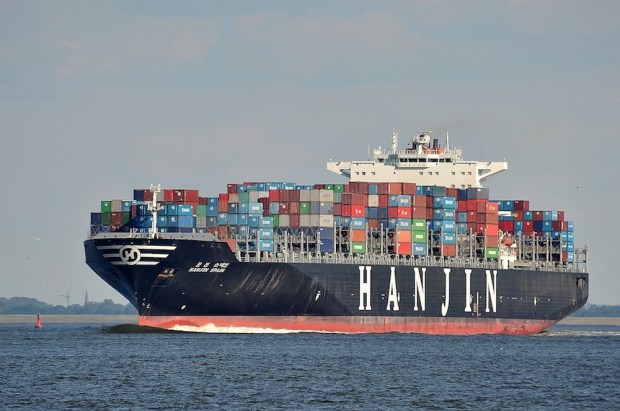Hanjin And $14 Billion Lost At Sea

When a major shipping player, like Hanjin, sails into financial uncertainty, the ripple effects are myriad and expensive. As of now, there is around $14 billion in goods currently stranded at sea and a legion of owners trying to get them back to land and into the hands of customers.
Dozens of ships carrying over a half a million cargo containers were already out to see when Hanjin declared bankruptcy last week, meaning those ships can not dock because it is unclear to port owners who is going to eat the cost of docking fees, container storage and unloading bills. Plus, some of those ships have been seized by the company’s creditors, which makes the status of the cargo all the more dicey.
“We’re passengers on a bus, and we’re being told we can’t get off,” Evan Jones, a lawyer for Samsung, said on Tuesday (Sept. 6) of its $38 million stranded on Hanjin ships in international waters.
Hanjin only amounts to about 3.2 percent of global container capacity; however, the disruption coming in the run-up to the holiday season is incredibly poorly timed.
While analysts aren’t expecting retail stock shortfalls for Christmas at this point, the longer the uncertainty lasts, the more likely negative effects to the whole supply chain become.
“This is not impacting store shelves now,” said Nate Herman, a senior vice president for the American Apparel & Footwear Association. “It will impact store shelves if the situation isn’t resolved.”
Hanjin does enjoy some bankruptcy protections issued by courts in both Korea and the U.S. Those protections allow Hanjin ships to move in and out of certain terminals in those countries without fear of asset seizures. But that doesn’t solve the fee issues or the problems in Asian or European ports.
Conditions within Hanjin are reportedly “bordering chaos,” said Lars Jensen, chief executive of SeaIntelligence Consulting in Copenhagen. “With so many Hanjin ships barred from entering ports, shippers have no idea when their cargo will be unloaded.”
This situation can not maintain forever, since both ships and sailors need fuel to stay at sea.
“We usually have food and water for about two weeks,” said the captain of a Hanjin-operated ship speaking by satellite phone from the South China Sea. But, after 12 days at sea, “everything is getting tight — food, water and fuel,” he said.
Water rationing has begun, and the captain noted that heat is becoming a factor in crew safety.
The delays are having a notable effect on shipping prices worldwide.
Sanne Manders, chief operating officer at California-based freight forwarder Flexport Inc., said rates on Asia-U.S. cargo have risen 40–50 percent since Monday on all sea lanes — not just those operated by Hanjin.
“That amounts to easily $600–$700 per container,“ Manders said. ”We think this period of high prices will be 30–45 days,” through the initial peak for Thanksgiving season shipping, he said.
And the hit will not come equally to all retailers, as delays are more easily ridden out by bigger players than smaller ones.
“For the top 25 importers, this is a blip,” said Frank Layo, a retail strategist at consulting firm Kurt Salmon. “They’re diversified; they’re not shipping it all on one line.” But for smaller retailers with less sophistication, “this could be devastating,” he said.
